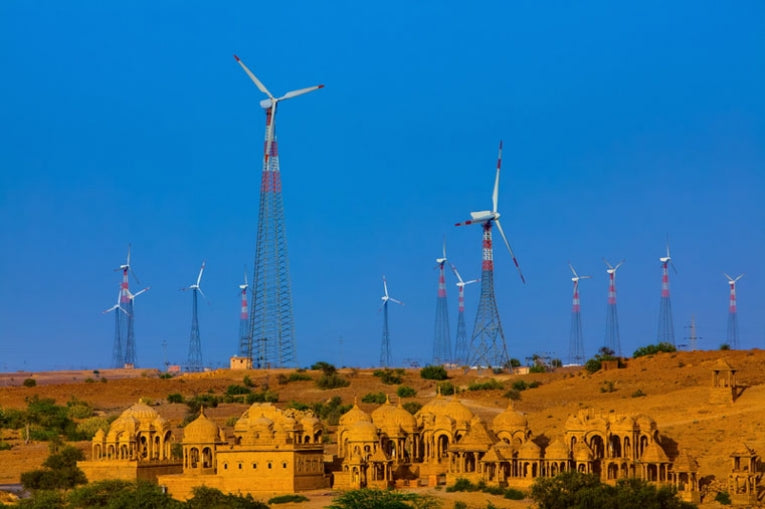Image: Wind turbines above Bada Bagh Cenotaph, Rajasthan State, India.
India is striving to corner a big slice of the green technology market, which might be worth as much as $2.2 trillion in 2020 (HSBC research) as the need for low carbon goods and services grows. Dr Kirit Parikh, a former member of India's Planning Commission, said: ''India has the opportunity to leapfrog the efforts of more developed economies by deploying newer, cleaner technologies. We have the capabilities, and the benefits to India in seizing this opportunity now will be transformational.''
India's share of the cake, as projected in a new report by The Climate Group is around 6% or $135 billion. This could create 10.5 million green jobs. India's Clean Revolution describes how a low carbon development path is the only one that will guarantee future prosperity for India. The report proposes that low carbon development is the only route that will ensure a better, more secure, and more prosperous future for its large population.
Other facts from the report: India is now fifth in the world in wind energy production; low wages and a highly skilled manufacturing base are expected to make India a major producer of clean technologies. India is also the world's fifth largest greenhouse gas emitter, according to the latest reliable information (CAIT 2007), with a heavy reliance on coal power stations, though India's strong economic growth has meant that demand for electricity often outstrips supply, which has reinforced the need for alternative energy sources.
Fortunately India has good wind and solar resources. The Indian Wind Energy Association has estimated that the onshore potential of wind energy for electricity generation is of the order of 65,000 MW. Besides being the fifth largest producer of wind energy in the world, India is a sunny country so solar energy is an obvious renewable power generation route. Already there are plans to build large solar power stations in suitable regions. Agricultural residue will be a good source of biomass and this is also expected to become a large source of alternative power.
Energy efficiency is going to become very important as it will help the country meet increasing demand while reducing emissions. Parts of its industry lag behind the developed nations in terms of energy efficiency and this needs to be a core part of any clean technology revolution.
Large investments from both public and private sector will be needed, if this scenario is to come to fruition. $60 billion will be needed to meet India's renewable energy targets. This large sum will need to be raised via public markets, corporate and private equity investors. The report identifies the need for innovative financial structures to generate the level of investment that will be necessary. A wide variety of incentives is proposed to help generate sufficient funds.
The report summarises, ''India's size, stage of economic development and entrepreneurial business community mean that it is well placed to leapfrog along the high growth, low carbon development pathway. The reward for success includes energy savings for businesses and households, improved international competitiveness, increased energy security, improved local air quality and the possibility to provide off-grid electricity to its vast, unconnected rural population.''
It concludes, ''With advances at all levels, particularly in resolving financing needs, the country's Clean Revolution is set to take off in a way that will benefit the global community, both through mitigating emissions and through developing clean solutions that are useful everywhere.''
Photo: Wind turbines above Bada Bagh Cenotaph, Rajasthan State, India © Pixattitude /Dreamstime.com
Link to report:










